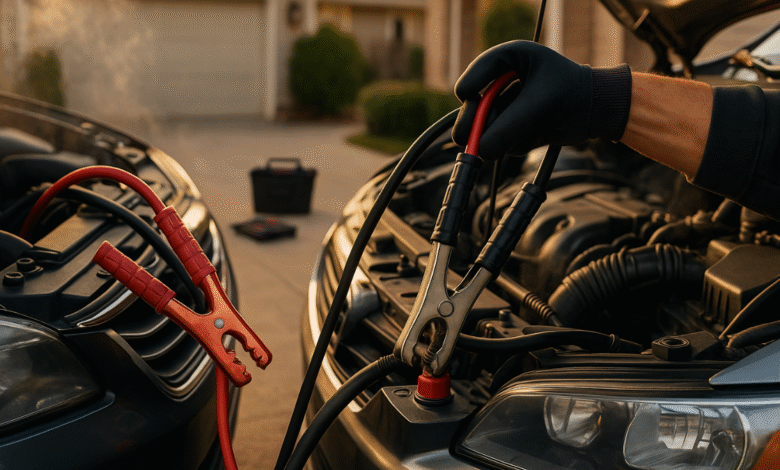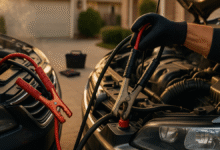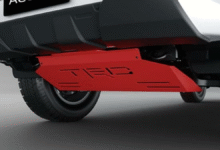How to Jump a Car: A Complete Expert Guide

Learn how to jump a car safely and effectively with expert tips. This detailed guide covers tools, steps, safety rules, and FAQs to help you restart your car battery.
Understanding the Basics of How to Jump a Car
When your vehicle refuses to start because of a dead battery, knowing how to jump a car becomes one of the most valuable skills you can learn. Car batteries can fail unexpectedly, leaving drivers stranded in inconvenient places like parking lots, driveways, or even on the roadside. Instead of panicking or waiting hours for roadside assistance, having the confidence to handle the situation yourself makes a huge difference.
The good news is that the process is simpler than most people imagine. While it involves handling jumper cables and connecting batteries, following the correct sequence of steps ensures both your safety and the health of your car. With a few minutes of patience and a little know-how, you can get your vehicle running again.
Why Learning How to Jump a Car Matters
Owning a vehicle comes with responsibilities, and knowing how to jump a car is one of the most practical skills for drivers. A battery may die for many reasons—leaving headlights on, cold weather, or simply because the battery is old. Without proper knowledge, you may end up stranded and dependent on others for help.
Additionally, learning how to jump a car gives you peace of mind. It equips you to assist not only yourself but also friends, family, or even strangers in need. There’s a certain level of confidence that comes from knowing you can solve a common roadside issue without stress.
Tools You Need Before You Jump a Car
Before attempting to jump a car, you need to have the right tools. The most important item is a reliable set of jumper cables. These heavy-duty cables come with insulated clamps—one red and one black—that attach to the battery terminals. The quality of the cables matters, as thicker cables allow better current flow and reduce the risk of overheating.
Another essential tool is a second vehicle with a fully charged battery. This donor car acts as a power source for your dead battery. In some cases, portable jump starters are also a great alternative. They are compact, easy to store in your trunk, and eliminate the need for another vehicle.
Safety Precautions When Learning How to Jump a Car
Safety is the most important part of learning how to jump a car. Batteries store electrical energy, and mishandling them can lead to sparks, burns, or even explosions in extreme cases. Always wear gloves and eye protection if you have them available, and make sure both vehicles are in park or neutral with their engines turned off before connecting the cables.
It’s also important to double-check the polarity. Mixing up the red and black clamps can cause serious damage to your vehicle’s electrical system. Always remember: red goes to positive, and black goes to negative or an unpainted metal surface. Keeping this simple rule in mind ensures you complete the process safely.
Step-by-Step Guide on How to Jump a Car
Jump-starting a vehicle may seem intimidating at first, but once you break it down, the process is straightforward. Here’s a clear sequence to follow:
- Position the working car close to the car with the dead battery but ensure the vehicles do not touch.
- Open both hoods and locate the battery terminals. Identify positive (+) and negative (–) markings.
- Attach the red cable clamp to the positive terminal of the dead battery.
- Attach the other red clamp to the positive terminal of the good battery.
- Attach the black cable clamp to the negative terminal of the good battery.
- Attach the remaining black clamp to an unpainted metal surface on the engine block or frame of the dead car.
- Start the working vehicle and let it run for a few minutes.
- Attempt to start the car with the dead battery. If it doesn’t work immediately, wait another minute and try again.
- Once the car starts, carefully disconnect the cables in reverse order.
This sequence ensures that the flow of electricity is controlled and reduces risks.
Common Mistakes People Make When Jumping a Car
One of the most frequent mistakes is mixing up the cable connections. Reversing the polarity can result in sparks or damage to both vehicles. Another common error is attaching the negative clamp directly to the dead battery’s negative terminal instead of grounding it to a metal part of the engine. Grounding reduces the risk of sparks near the battery, which could ignite fumes.
Many people also forget to let the working vehicle run for a few minutes before trying to start the dead car. Allowing the battery to build up a little charge increases your chances of success and reduces stress on the donor car’s alternator.
Expert Tips for Success When You Jump a Car
Experts recommend always carrying jumper cables or a portable jump starter in your trunk. Being prepared is half the battle. Another tip is to maintain your battery regularly by cleaning terminals and checking for corrosion. A clean connection ensures better conductivity, making the jump-starting process faster and easier.
Additionally, if you live in colder climates, be aware that batteries tend to discharge faster in freezing temperatures. Investing in a battery blanket or parking in a garage during winter months can help extend your battery’s life.
Table: Quick Reference for How to Jump a Car
| Step | Action | Safety Note |
|---|---|---|
| One | Park cars close but not touching | Keep brakes on and cars in park |
| Two | Attach red clamp to dead battery positive | Double-check polarity |
| Three | Attach red clamp to donor positive | Ensure secure connection |
| Four | Attach black clamp to donor negative | Avoid loose clamps |
| Five | Attach black clamp to engine ground | Prevent sparks near battery |
| Six | Start donor vehicle | Let it run a few minutes |
| Seven | Start dead car | Try again after a minute if needed |
| Eight | Disconnect in reverse order | Do not let clamps touch |
What to Do After You Jump a Car
Once your vehicle starts, keep it running for at least fifteen to twenty minutes. This gives your alternator time to recharge the battery. Driving the car instead of idling is better, as it puts less strain on the charging system.
You should also schedule a battery test soon after. If your battery continues to die repeatedly, it may need replacement. Jump-starting is a temporary solution—it gets you moving, but it doesn’t fix an underlying battery problem.
Inspiring Quote to Remember
“Preparation is the key to confidence. Knowing how to jump a car transforms a stressful breakdown into a moment of self-reliance.”
Frequently Asked Questions on How to Jump a Car
Can jumping a car damage my vehicle?
If done correctly, jumping a car is safe. The main risk comes from connecting the cables incorrectly. Always follow the right order and safety precautions.
How long should I leave the cables connected?
Keep the cables connected for a few minutes after starting the donor car. This gives enough time for the dead battery to build up some charge before starting.
Can I jump a car in the rain?
Yes, you can, but extra caution is needed. Rain itself isn’t dangerous since car batteries are low voltage, but ensure cables and connections don’t sit in puddles.
Do I need to replace my battery after jumping my car?
Not always. If the battery is relatively new, the issue may have been caused by leaving lights on. However, if the battery keeps dying, replacement is the best option.
What if my car still doesn’t start after jumping?
If your car doesn’t start after multiple attempts, the problem could be more than just the battery. It might involve the alternator, starter, or wiring, requiring professional help.
Conclusion: The Confidence of Knowing How to Jump a Car
Learning how to jump a car is a practical skill every driver should master. It gives you independence, reduces stress, and helps you get back on the road quickly. While the process may seem intimidating at first, once you understand the steps and safety rules, it becomes second nature.
The next time your battery dies, instead of panicking, you’ll know exactly how to handle the situation. With the right tools and confidence, jumping a car isn’t just about reviving a dead battery—it’s about empowering yourself as a driver.



